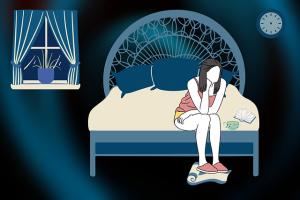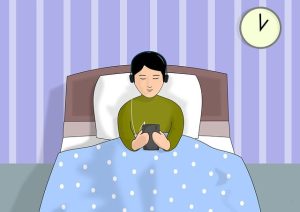Can a ritual help you to go to sleep peacefully, without emotions keeping you awake?
 A ritual can be very effective in helping you go to sleep peacefully, without emotions keeping you awake. Creating a bedtime routine or ritual can signal to your body and mind that it’s time to wind down, making it easier to transition into sleep.
A ritual can be very effective in helping you go to sleep peacefully, without emotions keeping you awake. Creating a bedtime routine or ritual can signal to your body and mind that it’s time to wind down, making it easier to transition into sleep. 
Here are some ways in which a ritual can help. Choose the ones that suit you best.
This article contains affiliate links
Consistency and Habit Formation
A consistent, routine pre-sleep ritual helps your body and mind recognize that it’s time to sleep. This could involve activities like dimming the lights, reading a book, or listening to calming music. To help you sleep peacefully it should also include going to bed at the same time every night. This can help regulate your body’s internal clock, making it easier to fall asleep and wake up at the same time each day.
Mindfulness and Relaxation Techniques
Incorporating mindfulness exercises such as deep breathing, meditation, or gentle yoga can help calm your mind and reduce the impact of emotions that might otherwise keep you awake. A Progressive Muscle Relaxation technique involves tensing and then slowly relaxing each muscle group in your body, which can help release physical tension and calm your mind. You can download MP3s on mindfulness, relaxation and more from a number of places that you can use for this. Aromatherapy may also be helpful in helping you relax. Using calming scents like lavender or chamomile can promote relaxation and make it easier to fall asleep.
Journaling
 Journaling can be a powerful tool for promoting better sleep, especially if emotions or racing thoughts keep you awake at night. Writing down your thoughts and feelings before bed can help you process and release emotions, preventing them from lingering and disrupting your sleep. Journaling can help in two ways here, by listing the things you want to do tomorrow, you avoid having your mind go over them to try and remember what you need to do. And by writing out your feelings about what happened during the day, you can calm your mind ready for sleep. Journaling allows you to express and process your emotions, helping to release any pent-up feelings that might be lingering in your mind. Writing down your thoughts can make them feel less overwhelming, as it provides an outlet for your emotions rather than letting them swirl around in your head. Your journal is for your eyes only. This freedom allows you to be completely honest, which is crucial for emotional release.
Journaling can be a powerful tool for promoting better sleep, especially if emotions or racing thoughts keep you awake at night. Writing down your thoughts and feelings before bed can help you process and release emotions, preventing them from lingering and disrupting your sleep. Journaling can help in two ways here, by listing the things you want to do tomorrow, you avoid having your mind go over them to try and remember what you need to do. And by writing out your feelings about what happened during the day, you can calm your mind ready for sleep. Journaling allows you to express and process your emotions, helping to release any pent-up feelings that might be lingering in your mind. Writing down your thoughts can make them feel less overwhelming, as it provides an outlet for your emotions rather than letting them swirl around in your head. Your journal is for your eyes only. This freedom allows you to be completely honest, which is crucial for emotional release.
If you feel anxious, by putting your worries on paper, you can often see them more clearly and recognize that some concerns may not be as urgent as they feel. This process can help reduce anxiety and create a sense of relief, making it easier to relax before bed. If you have a lot on your mind, journaling can help you organize your thoughts. Writing things down can provide clarity, allowing you to see what’s truly important and what can be set aside for another time. This can prevent your mind from jumping from one thought to another as you try to fall asleep.
Decision-Making
If you’re grappling with a decision, journaling can help you weigh the pros and cons, leading to more peace of mind. Once you’ve explored your options on paper, you might feel more at ease, knowing you’ve taken a step toward resolving the issue. Even if you don’t make a decision before going to sleep, you may find that the decision gets made overnight as your subconscious processes all your thoughts on the matter and finds a useful solution for you.
Reflecting on your day, your emotions, and your thoughts can give you a deeper understanding of yourself. This self-awareness can help you identify patterns or triggers that might be affecting your sleep, allowing you to address them more effectively. Ending your journaling session with a focus on gratitude or positive experiences can shift your mindset away from stress and toward a more peaceful state. Reflecting on things you’re grateful for or happy about can help foster a sense of contentment, which is conducive to sleep.
Journaling can serve as a ritual that signals the end of the day, helping you mentally transition from the busyness of your day to the calm of the night. It can create a boundary between your waking life and your sleeping time, making it easier for your mind to let go of the day’s stresses. The act of journaling itself can become a comforting ritual. The routine of sitting down with a pen and paper at the same time each night can signal to your body that it’s time to wind down and prepare for sleep.
Aim to journal for 10-20 minutes before bed. This keeps the practice focused and prevents it from becoming another stressor if you feel the need to write extensively.
Don’t worry about grammar, spelling, or structure. The goal is to let your thoughts flow freely without judgment. If you’re prone to anxiety, try to end your journaling with something positive, like writing down three things you’re grateful for or a positive affirmation for the next day. By incorporating journaling into your bedtime routine, you create a space to offload emotional baggage, clarify your thoughts, and cultivate a positive mindset, all of which can significantly enhance your ability to sleep peacefully.
Read or Listen to Soothing Content:
Engaging in activities that occupy your mind in a gentle, non-stimulating way can help distract you from emotional stressors.
Visualization
Imagining a peaceful scene or focusing on positive, calming thoughts can help shift your focus away from any distressing emotions.
Environmental Adjustments
Make yourself a comfortable sleep environment. Ensure your bedroom helps you sleep. It needs to be cool, quiet, and dark, which may mean removing a TV or computer or other blue-light electronic gadget from your bedroom. This can help create an atmosphere that supports relaxation and emotional calm.
By establishing a consistent and soothing bedtime ritual, you create a sense of predictability and comfort that can help mitigate the impact of emotions on your sleep. Over time, your mind and body will begin to associate these activities with sleep, making it easier to drift off peacefully.
Coloring for Relaxation
Including a coloring page as part of your bedtime routine can be very helpful for promoting relaxation and peaceful sleep. Coloring, especially using simple, repetitive patterns like mandalas or nature scenes, can have several calming effects that aid in winding down before bed.
Mindfulness and Focus:
Coloring encourages you to focus on the present moment, helping to quiet the mind and reduce the impact of any racing thoughts or emotions. This mindfulness can create a sense of calm that is conducive to sleep. The act of coloring can be meditative. The repetitive motion of coloring within the lines can soothe the mind and body, reducing stress levels and helping you to relax.
Creative Expression:
Like journaling, coloring allows for creative expression, which can help in processing emotions. The use of color and design can reflect your mood, providing a non-verbal outlet for feelings that might be difficult to express in words. Sometimes, emotions are hard to put into words. Coloring can serve as a gentle way to reflect on your emotional state without needing to articulate those feelings directly, which can be especially useful when you’re feeling overwhelmed.
Physical Relaxation
The fine motor movements involved in coloring can promote physical relaxation. Focusing on small, detailed areas can help release tension in your hands and fingers, which can have a relaxing effect on the entire body. As you get absorbed in coloring, your breathing might naturally slow down, mimicking the breathing patterns associated with relaxation techniques, further aiding in the winding-down process. You can intentionally choose calming colors, such as blues, greens, and pastels, which are known to have a soothing effect on the mind. The gentle hues can help create a tranquil atmosphere, making it easier to transition to sleep.
Coloring in a quiet, dimly lit space can create a peaceful environment. It allows you to engage in a low-stimulation activity that doesn’t involve screens, which can disrupt sleep due to blue light exposure. If you have been journaling, you might then spend a few minutes coloring. This combination of journaling and coloring can help you process emotions through writing first, then gradually wind down with the calming, meditative act of coloring. You can even use coloring as a form of reflection. For example, after writing in your journal, you might choose colors that represent your feelings or thoughts from the day, using the act of coloring as a way to internalize and process what you’ve written. A coloring journal can let you do both of these in one place. For instance the “Love Notes” journals have a coloring picture on each page, plus a space to add your own inspirational or relaxing quote and space to journal.
Break from Technology
Coloring provides a relaxing activity that is screen-free, helping you avoid the stimulating effects of phones, tablets, or computers before bed. This is crucial for maintaining healthy sleep patterns, as screen time before bed can interfere with your ability to fall asleep.
Gentle Transition to Sleep
Coloring can be part of a broader wind-down routine that includes dim lighting, soft music, or aromatherapy. As a calming pre-sleep activity, it can help signal to your body that it’s time to prepare for rest.
Including a coloring page in your bedtime ritual can enhance your ability to relax, reduce stress, and create a mental and emotional space that is conducive to peaceful sleep.